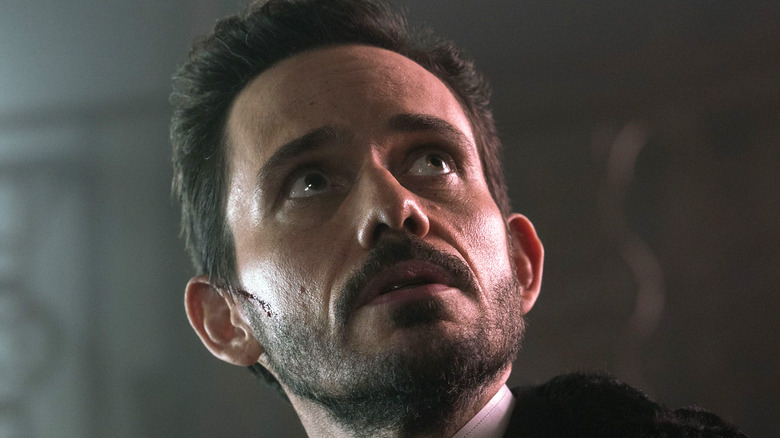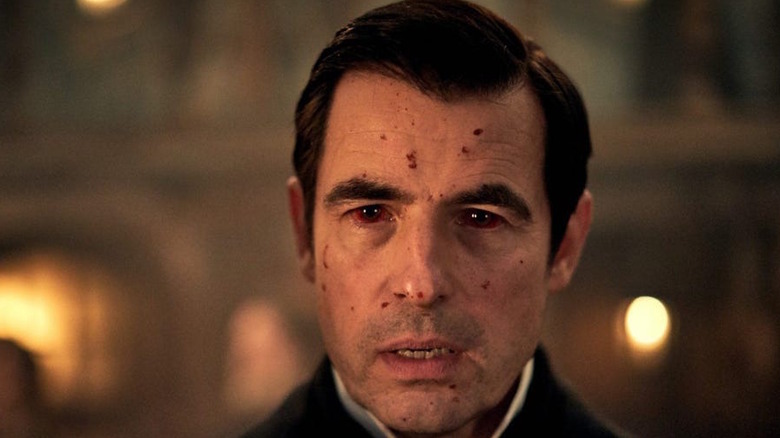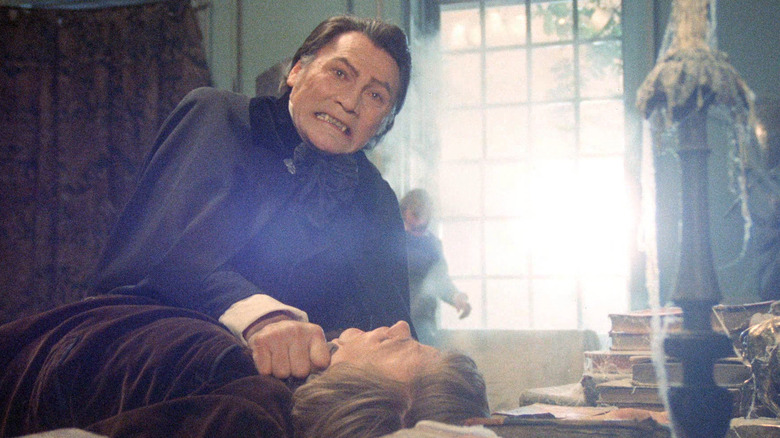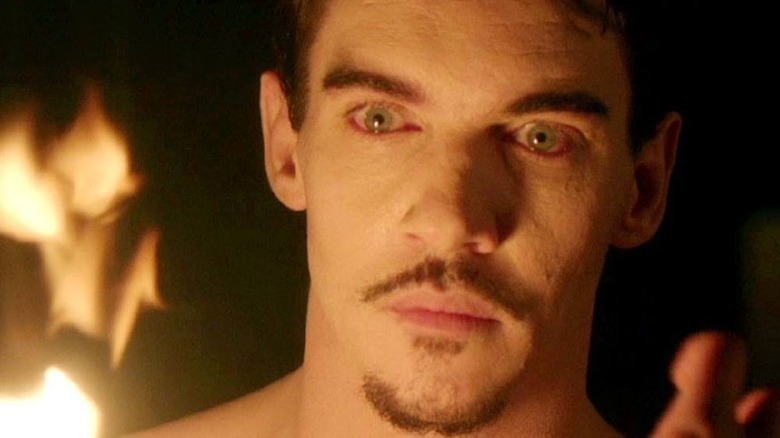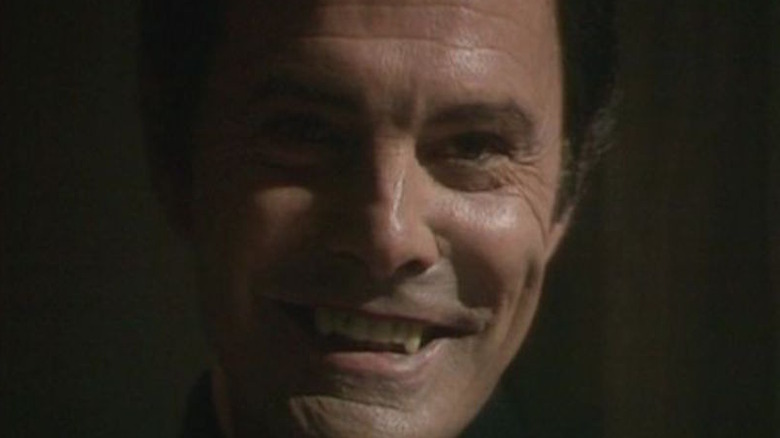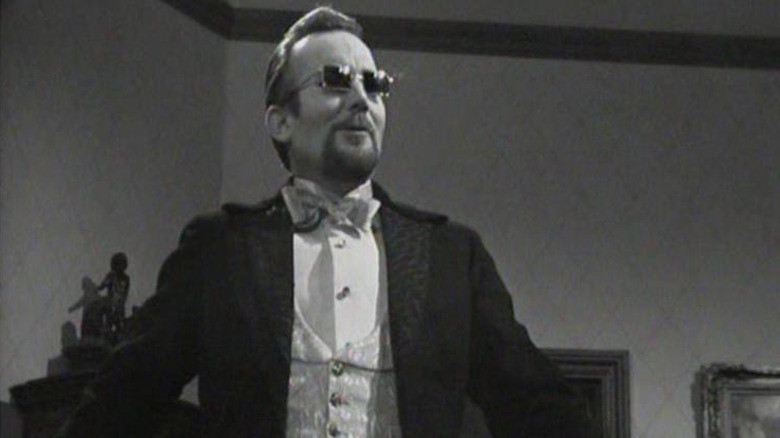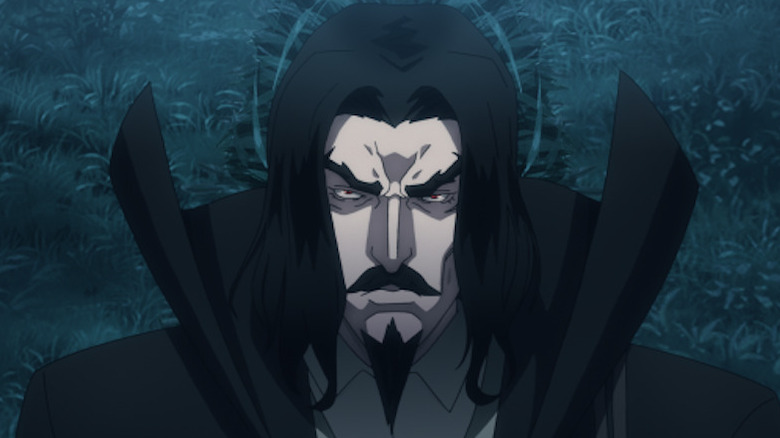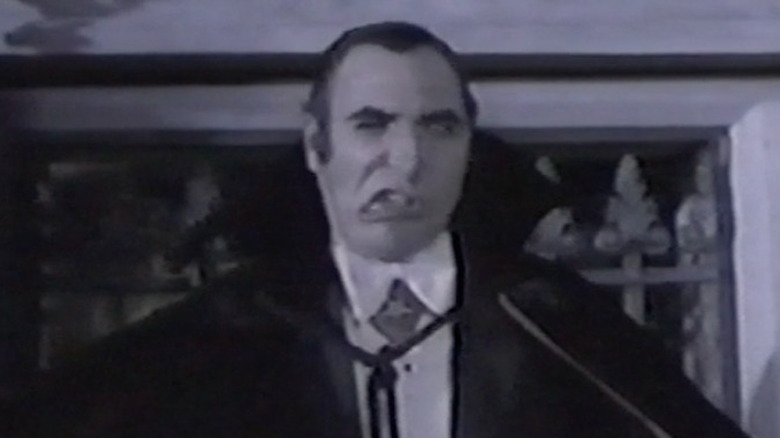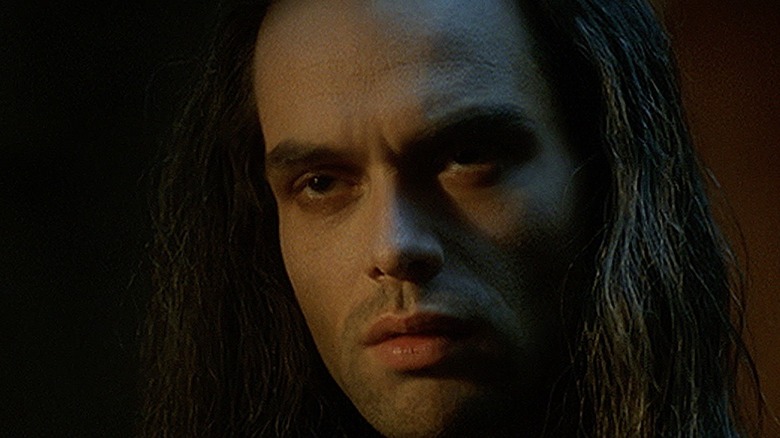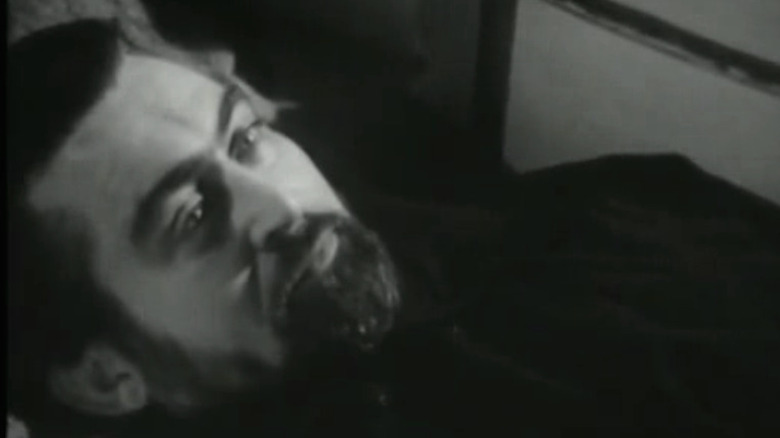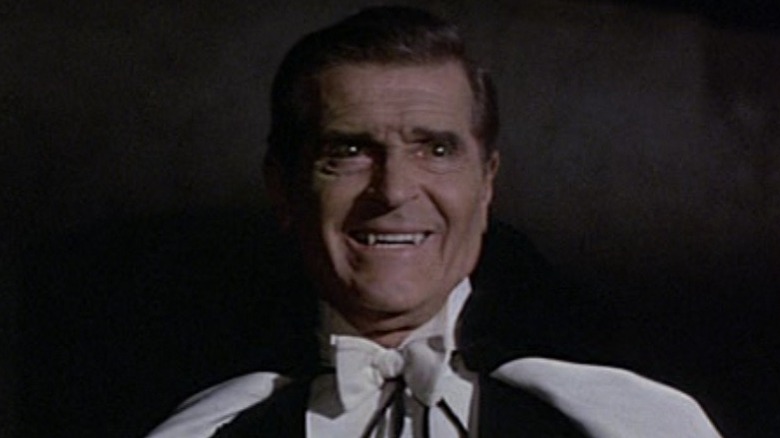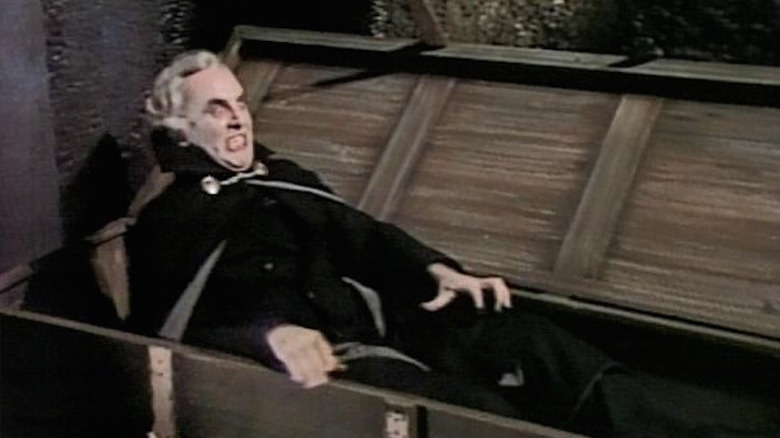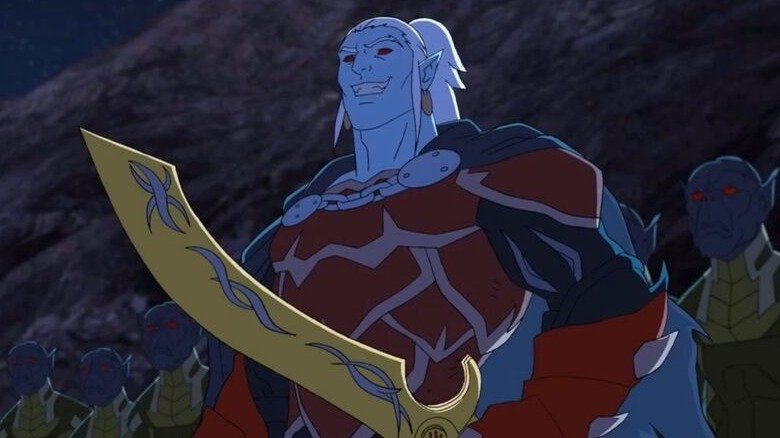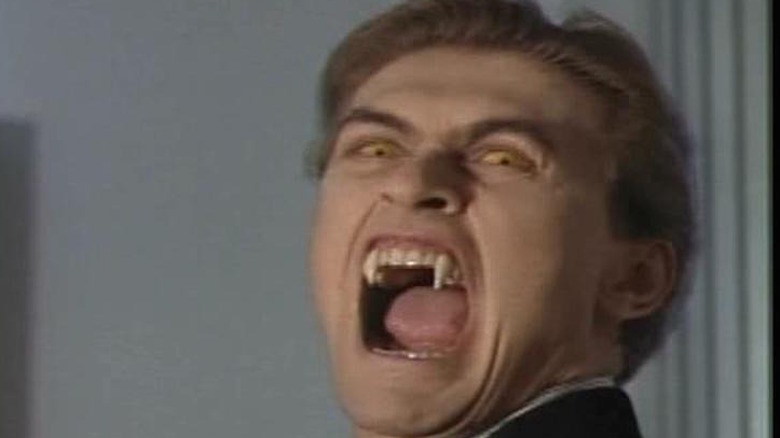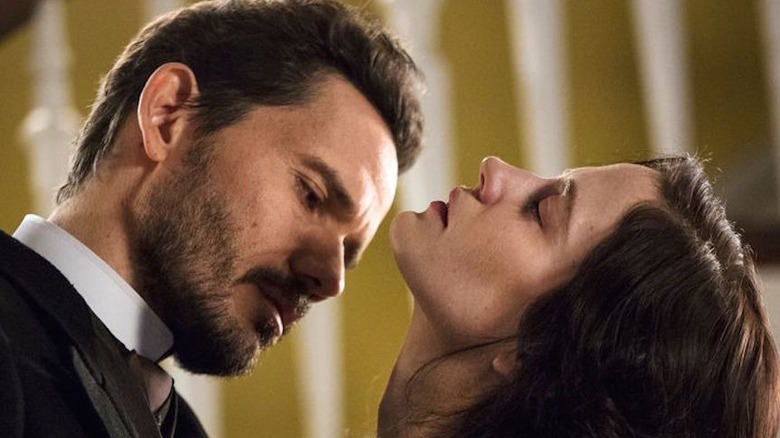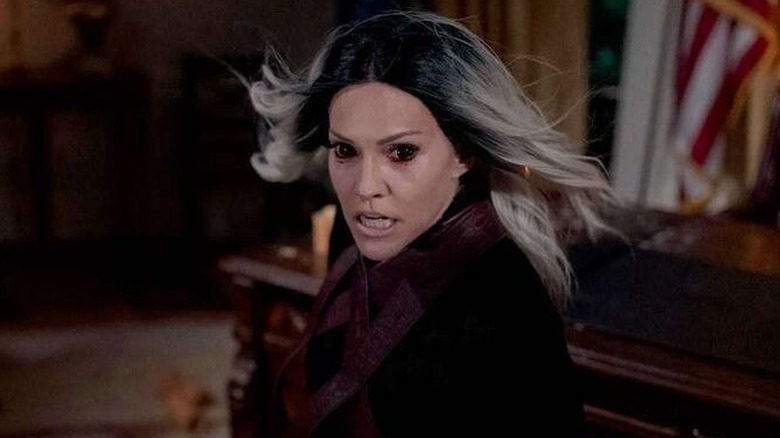The Many Faces Of Dracula On Television
Though the movies may claim the most famous screen adaptations of Bram Stoker's immortal character Dracula, the vampire has also enjoyed a long and diverse career on television. Since the late 1960s, small screen versions of Stoker's novel have brought Gothic menace to TV screens in the United States, United Kingdom, Italy, Czechoslovakia, and India, while his monstrous antagonist has turned up as a guest villain in series ranging from "Doctor Who" and "Supernatural" to "Chilling Adventures of Sabrina" and even Adult Swim's "Decker." These are just a handful of TV takes on Dracula, which holds the Guinness World Record as the non-human character with the most screen adaptations (272).
Following is an all-inclusive, globe-spanning look at some of the best TV adaptations or appearances of Dracula, as well as a few that might be relatively new to vampire devotees. Grab your crosses and your stakes: it's time to stare deeply into the many faces of Dracula on television.
Claes Bang was a cool, cruel Dracula for Netflix
"Sherlock" creators Steven Moffatt and Mark Gattis' 2020 take on "Dracula" doesn't reinterpret the Bram Stoker novel as much as it turns the material inside out, completely revising the plot, reworking established vampire lore, and even moving the action to the present day in the final episode. Their vampire also gets a rewrite: though he retains some of his trademarks from novel and screen, including an ability to transform (messily) into animals, the monster, played by Danish actor Claes Bang, stands apart from previous Draculas in many ways.
Bang's Dracula is charming and urbane, much like Christopher Lee's Dracula, but also blessed with a wicked sense of humor ("You look drained," he purrs at one point). That sharp wit hides an abiding sense of smugness and superiority that oozes from every pore; Bang's Dracula dominates not only by supernatural power but personality and ego. At the same time, this Dracula is plagued by insecurities: Moffatt and Gattis reveal that many of the timeworn ways to ward off or kill a vampire can't actually hurt him in a physical sense. For all of his manners and attitude, Dracula seems to consider himself a freak, and allows superstition to keep him in the shadows where he feels he belongs. Of the many ways in which "Dracula" rewrites the vampire story, its vampire is the most modern and inventive twist.
Jack Palance: world's toughest Dracula
One of several TV-movie adaptations of Gothic horror fiction produced and directed by "Dark Shadows" creator Dan Curtis in the 1970s, "Dracula" — also known as "Bram Stoker's Dracula" — hews as closely to the source novel as the later Francis Ford Coppola film of the same name. Which is to say: It deviates wildly from the book, adding a romantic subplot and turning Dracula into a tragic romantic, neither of which work particularly well, even in the hands of a skillful scriptwriter like fantasy fiction legend Richard Matheson. However, it does have the benefit of Oscar winner Jack Palance as its Count.
Though saddled with a drippy reincarnation subplot that explains his obsession with Fiona Lewis' Lucy, Palance's Dracula has an imposing presence and considerable physicality, which he shows off in the sequence where he finds Lucy dead and destroys her tomb, and later, in the showdown with Nigel Davenport's Van Helsing and Simon Ward's Arthur Holmwood. Palance may inspire the occasional giggle by hissing or exhaling through all of his lines, but there's no denying that from the standpoint of sheer physical power, he's an imposing Dracula on par with Christopher Lee or Claes Bang.
Few viewers saw Jonathan Rhys Meyers' TV Dracula
For a brief period of time in 2013, Dracula visited homes each week in the form of Jonathan Rhys Meyers, who starred as the legendary count in NBC's "Dracula." The series wove the character into an inventive plot: the vampire teamed with his nemesis Van Helsing (played by Thomas Krestchmann, who essayed the Count in Dario Argento's "Dracula 3D"), to fight a mysterious power-hungry organization. Dracula also hid his identity by posing as an American businessman in order to infiltrate the order.
Lavishly appointed with elaborate Victorian sets (built in Hungary) and positively overflowing with spilled blood and heaving corsets, "Dracula" failed to catch on with audiences and disappeared after a season. The premise, which attempted to parallel vampirism with corporate greed, might have yielded interesting results, given a chance to take root. And Rhys Meyers' Dracula, though slight of frame and saddled with an unfortunate goatee, was the right blend of sexy rake and bloodthirsty monster. Too bad few people saw him do it.
Louis Jourdan was a romantic, melancholy vampire
The BBC's 1977 production of "Count Dracula" emphasized the concept of the vampire as a Gothic romantic figure: the two-and-a-half-hour, shot-on-video teleplay bills itself in those terms — and chooses an actor synonymous with Old World romance to play the Count. French actor Louis Jourdan, who was a suave presence in Hollywood films from the 1940s and '50s like Hitchcock's "The Paradine Case" and "Gigi," played Dracula as more lover than monster, displaying courtly manners and bedroom eyes to Susan Penhaglion's Lucy and Judi Bowker's Mina, both of whom fall (understandably) under his sway.
Jourdan also brings an appealing touch of melancholy to his Dracula, which balances the smoldering side of his performance. The hint of sadness in Jourdan's face and his languid movements seem to suggest a weariness with the business of being a vampire — the blood-drinking, the stalking, the coffins. It's not all seduction and midnight rendezvous, Jourdan seems to telegraph to the audience. That compelling combination, along with Philip Saville's atmospheric direction, makes the BBC "Count Dracula" one of the most effective TV adaptations.
Denholm Elliott's Dracula: unlikely but effective
Oscar-nominated British actor Denholm Elliott — best known to American audiences for genteel or eccentric roles like Dan Aykroyd's butler in "Trading Places" and Marcus Brody in two Indiana Jones films — was an unusual choice to play Dracula in a 1968 episode of the UK horror anthology series "Mystery and Imagination." But he proves more than capable of handling the character, whose depiction here hews closer to Christopher Lee's tall, dark, and gruesome take for Hammer from the same period.
Elliott looks quite suave in his goatee and groovy sunglasses, and throws himself into the nighttime attacks on Lucy (Susan George) and Mina (Suzanne Neve), for which the sexualized elements of vampirism get maximum emphasis (despite Elliott's gnarly fangs). However, he folds like an undead deck of cards when Bernard Archer's Van Helsing and James Maxwell's Dr. Seward and begs for mercy before being crumbling into dust in the rays of dawn. Though this is less well known than many other "Dracula" adaptations, film critic Kim Newman rightly notes that it features many story elements that were later echoed in other versions — especially the Francis Ford Coppola" Dracula" — such as the depiction of Dracula as a cooler, sexier alternative to stuck-up Victorian men.
Graham McTavish voices Castlevania's vengeful Dracula
In Netflix's animated adaptation of the classic Konami video game series "Castlevania," monster hunters team with the half-human son of Dracula to fight his father's army of demons as they attempt to overtake the Eastern European country of Wallachia. The series' Dracula is a formidable figure, possessed of both supernatural power and scientific knowledge, but he's also a surprisingly sympathetic character. His war on humanity is motivated not by bloodlust or power, but loss: his wife was burned at the stake for witchcraft by superstitious villagers.
Graham McTavish provides Dracula with a sonorous voice and complex emotions in "Castlevania," which represents just one of many voice-over roles the Scottish actor essays. Among them are characters on "Teenage Mutant Ninja Turtles," "DuckTales," "Avengers: Earth's Mightiest Heroes," and video games like "Warhammer 40,000: Dawn of War II – Retribution" and "Call of Duty: Modern Warfare 2." However, he's also well known for his live-action projects, which include the "Hobbit" trilogy, "Outlander," "Lucifer," and "House of the Dragon."
Judd Hirsch goes for the jokes in The Halloween That Almost Wasn't
Judd Hirsch took time away from his Emmy-winning turn as Alex Reiger on "Taxi" to star as the Prince of Darkness in the 1979 ABC TV special "The Halloween That Almost Wasn't." The Emmy-winning comedy, which was also released on home video as "The Night Dracula Saved the World," found Hirsch's Dracula in a panic over rumors of Halloween's cancellation and fighting back by rallying his fellow movie monsters into abandoning their family-friendly images in favor of old-fashioned scares. The anti-Halloween campaign was later revealed as a campaign by Mariette Hartley's Witch, who had grown tired of her second-tier monster status and constant jokes about her creepy appearance.
As Dracula, Hirsch adopts a thick, Bela Lugosi-style accent and a comic delivery that suggests an undead Jackie Mason. Though barn-door broad in any other context, Hirsch's take is perfect for the special's intended audience of grade schoolers, and is echoed by the other players, which include John Schuck as the Frankenstein Monster (presaging his turn as Herman Munster in "The Munsters Today") and Jack Riley of "The Bob Newhart Show" as the Wolf Man. Hirsch appears to delight in his chance to cut loose, as evidenced by his exuberant disco dance number with Hartley in the movie's finale.
Rudolf Martin tackled two sides of Dracula for TV
German actor Rudolf Martin's credits include features like "Ford v. Ferrari" and "Swordfish" and numerous television appearances, including episodes of and recurring roles on "24," "NCIS," "Mad Men," and "Dexter." He also played two very different versions of Dracula for two separate television projects in 2000: Martin was the fictional Count Dracula in Season 5 of "Buffy the Vampire Slayer," and also played his real-life inspiration, the 15th century ruler of Wallachia and allegedly brutal military leader in "Dark Prince: The True Story of Dracula."
Martin discussed his two takes on Dracula in an email conversation with Looper. In regard to "Dark Prince," Martin wrote that he conducted intensive research into Vlad's life. "I wanted to get as much of an understanding of his life and his time as possible — what might have been driving him, as well as a sense of what life was like." As Martin noted, "There are no vampires in ['Dark Prince']" — unlike "Buffy," which he filmed just a few months later. "I decided to ham it up and just be a vampire," Martin recalled. "I mostly leaned on the vampire played by Klaus Kinski in the great film 'Nosferatu the Vampyre' from 1979."
Curse of Dracula gave us a multipart TV Dracula with Michael Nouri
Michael Nouri of "Flashdance" and "Yellowstone" fame was a soulful vampire in 1979's "The Curse of Dracula," which was one of three separate serialized shows that aired on NBC as part of an umbrella series called "Cliffhangers." Designed as a tribute to theatrical serials of the 1930s like "Flash Gordon," each of the three shows on "Cliffhangers" ended (appropriately enough) on what the producers hoped would be a suspenseful moment that brought viewers back to find out what happened each week. Unfortunately, the gambit didn't pay off: the network axed "Cliffhangers" after 10 episodes, leaving all of the stories unfinished.
Nouri's Dracula is a sympathetic figure on par with Gary Oldman's Count in "Bram Stoker's Dracula": posing as a college history professor (who only teaches night courses), Dracula here is a hopeless romantic doomed to destroy the women he loves. These include the mother of vengeful Carol Baxter, who teams with the grandson of Professor Van Helsing to bring down the vampire. Nouri has both the talent and the looks to pull off the lover and monster side of his character.
The 10 episodes of "Curse of Dracula" were later edited into two TV movies, one of which (also titled "The Curse of Dracula") featured an ending that differed from the series' conclusion, with Dracula surviving a stake through the heart.
Czech TV aired its own Dracula in 1971
A burly, bearded Count dominates "Hrabe Drakula," a 1971 adaptation of Stoker's novel made for Czechoslovakian television. Actor Ilja Racek is a subdued Dracula here, who resides in an exceptionally atmospheric (and from the looks of it, apparently real) ruined castle attended by three ghostly brides. But Racek — a prolific stage actor in his native Czechoslovakia until his death in 2018 — also brings a slow-boiling menace to the role, which echoes the adaptation's understated Gothic vibe.
Clocking at a brief 76 minutes, "Hrabe Drakula" is notable for several reasons beyond Racek's robust Dracula. It's the first adaptation of "Dracula" helmed by a woman (co-scripter Anna Prochazkova), and the first to feature several elements from the Stoker novel that went unseen from "Dracula" films prior to its release. These include the scene in which Dracula descends face-down on the walls of his castle, and a grisly moment in which the Count wards off his brides, who appear as little more than ghosts here, with the offering of a baby. It also features a somewhat novel means of dispatching the vampire, who dies here when a thrown dagger pierces his heart.
Francis Lederer's Dracula added chills to Night Gallery
"The Devil is Not Mocked," which aired shortly before Halloween in 1971 as part the second season of NBC's horror anthology "Night Gallery," folded Dracula into a depiction of real-life horror: the Nazi occupation of Eastern Europe during World War II. The episode, directed by veteran "Night Gallery" helmer Gene Kearney, who also adapted Manley Wade Wellman's short story, starred Austrian actor Helmut Dantine as a German general whose troops occupy a remote castle in the Balkans. The castle's master, whom Dantine believed was a resistance leader, proved instead to be a gracious host — until the stroke of midnight, when courtly manners are dropped and fangs are bared.
Austro-Hungarian actor Francis Lederer, who played Dracula in "Devil," had some experience with the role, having previously played the Count in the low-budget 1958 American chiller "The Return of Dracula." His turn in the episode, which also marked his final screen appearance, does well by both sides of Dracula's personality: he's elegant and infinitely patient in the moments before his transformation, and terrifying after it, declaring himself "the proud commander" of his castle from behind prosthetic fangs and red-streaked contact lenses.
From Canada came Norman Welsh's theatrical TV Dracula
Norman Welsh gave a highly melodramatic performance as Dracula in a 1973 small-screen adaptation for the Canadian anthology series "Purple Playhouse." Outfitted with sweeping white hair and colossal fangs, Welsh's English-accented Dracula cuts a stately figure, which when combined with the actor's sepulchral voice, more than sells the notion of the vampire's overwhelming, magnetic presence. There's not a great deal of subtlety to Welsh's performance, but there's also little room for nuance, given the production's slimmed-down storyline, which removes a number of supporting characters, and limited budget.
Welsh, a noted stage actor in his native Canada (and apparently also a frequent guest performer as Santa Claus on "MisteRogers"), is perhaps less well-known to mainstream audiences than two of his castmates, both from America. Emmy nominee Blair Brown ("Orange Is the New Black") played the vampirized Mina Murray, and character actor Nehemiah Persoff ("Yentl"), who died in 2022 at the age of 102, was Van Helsing.
Corey Burton voiced a warrior Dracula for Marvel Animation
If you've enjoyed an animated series in the last three decades, chances are you heard one or more characters voiced by actor Corey Burton. A staggeringly prolific presence in daytime episodic cartoons, Burton has lent his protean voice to countless Disney and Hasbro-related series, among many other programs. He also provided the voice of Dracula for three Marvel animated series: "Avengers Assemble," "Hulk and the Agents of S.M.A.S.H," and "Ultimate Spider-Man," all of which aired on Disney XD as part of its Marvel Universe block.
The Dracula depicted on the three series resembles the one featured in the "Curse of the Mutants" storyline which ran in "X-Men," "Namor the First Mutant," "Deadpool" and "Wolverine and Jubilee: Curse of the Mutants" in 2010 and 2011. Tall, powerfully built, and outfitted in armor and a cape, the animated Dracula is a powerful foe for each of the hero teams represented in their respective series. Burton's voice for Dracula is deep and resonant, and sounds similar to his voice for Count Dooku on "Star Wars: Clone Wars" and related media. Burton conveys the character's vast power and knowledge with simple line readings, which is no small feat.
Geordie Johnson was a kid-friendly Count on Dracula: The Series
Actor Geordie Johnson played a youthful, blonde-haired Count in disguise in the Canadian TV drama "Dracula: The Series," which aired in syndication in 1990 and 1991. Johnson's Alexander Lucard, or A. Lucard (read that backwards), was a wealthy industrialist — a plot element shared with Hammer's "Satanic Rites of Dracula" from 1973 — whose machinations were constantly foiled by a trio of kids that included Mia Kershner, who later played a vampire queen in "30 Days of Night: Dark Days," and a descendant of Professor Van Helsing. Since "Dracula: The Series" was slanted towards young viewers, their clashes were largely bloodless and even occasionally comic, with Dracula reacting to the kids' invasion of his castle with the sort of aggravation Mr. Wilson directed towards Dennis the Menace.
Johnson's Count isn't particularly frightening, but he does have a light touch in comic moments. He also gets an oddly touching relationship with Klaus, a former follower who also happens to be Van Helsing's son. Played by Geraint Wyn Davies — who himself would play a popular vampire on another Canadian series, "Forever Knight" — the scenes between Klaus and Alucard have sardonic humor and even a touch of emotional depth that seems pulled from another series altogether.
Penny Dreadful added Dracula to its roster of monsters
Introduced in Season 3 of "Penny Dreadful," Christian Camargo's take on Dracula hits many of the notes that viewer have come to understand about the role. He's seductive, bloodthirsty, and enigmatic, and drawn inexorably to one woman, which here is Eva Green's monster hunter, Vanessa. And while Camargo's Dracula may borrow a bit from the one played by Jonathan Rhys Meyers — both impersonate researchers (the "Penny Dreadful" Dracula impersonates a socially awkward zoologist) in order to interact with the living — there's also one major difference from any other interpretation.
"Penny Dreadful" elevates Dracula from major monster to archfiend. In the show's mythology, he's the brother of Lucifer himself, and cursed with eternal life after his fall from Heaven to Earth. He spent millennia seeking the only path back to God's domain: by partnering with the Mother of Evil, another fallen angel who just happened to inhabit Vanessa. Much of Dracula's tenure on Season 3 involves various attempts to seduce Vanessa while also balancing his newfound love for her.
Van Helsing and Tricia Helfer delivered a female Dracula
Though British actor Ingrid Pitt was memorably cast in 1971's "Countess Dracula," the Hammer Film Production actually took a highly fictionalized look at Elizabeth Bathory, a 17th century Hungarian noblewoman who reportedly murdered members of her family and, according to legend, bathed in blood to preserve her youth. It took another four-plus decades to bring a true female interpretation of Dracula, which occurred on the SyFy series "Van Helsing."
Tricia Helfer of "Battlestar Galactica" fame played Countess Olivia von Dracula in Seasons 4 and 5 of "Van Helsing," and quickly became the show's primary antagonist. The wife of Transylvanian Count Dalibor (Kim Coates), the Countess became the human host of an entity known as the Dark One, from which all vampires throughout history have spawned. Having expertly portrayed another all-powerful female character — Number Six — on "Galactica," Dracula's world-domination plans, which eventually include taking over the White House, seem entirely natural in Helfer's hands.
